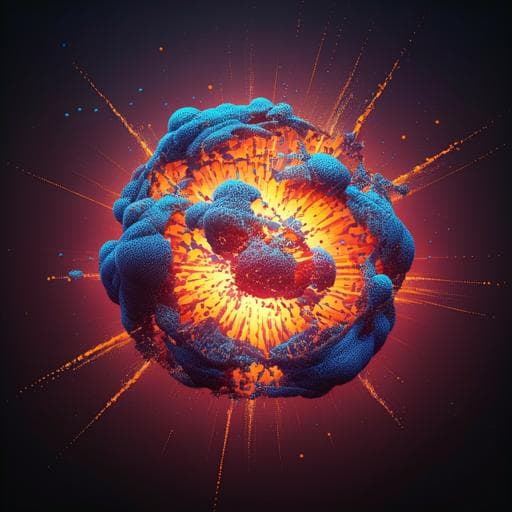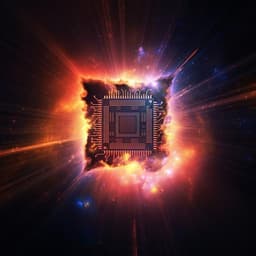
Physics
Megahertz single-particle imaging at the European XFEL
E. Sobolev, S. Zolotarev, et al.
Experience the groundbreaking potential of high repetition rate X-ray pulses in single-particle imaging, as demonstrated by a team of esteemed researchers. This innovative study by Egor Sobolev, Sergei Zolotarev, Klaus Giewekemeyer, and others unveils solutions overcoming challenges in sample injection and detector technology, promising to revolutionize the field of X-ray imaging.
~3 min • Beginner • English
Introduction
This study investigates whether single-particle imaging (SPI) can be performed at the megahertz intrabunch repetition rates provided by the European XFEL (EuXFEL). XFEL femtosecond pulses can outrun radiation damage, enabling room-temperature imaging of biological particles. Prior SPI work has imaged cells, organelles, and viruses, but reconstructions are limited in resolution due to weak scattering signals, detector dynamic range limits, background noise, and shot-to-shot variability. Achieving higher resolution requires averaging many snapshots, which has been limited by low hit rates and low repetition rates (typically 120 Hz). The EuXFEL’s superconducting linac enables pulse trains at up to megahertz rates, dramatically increasing data throughput. The core question is whether all components—sample delivery, detection, and data acquisition—can operate without cross-pulse interference at MHz rates while maintaining low background and stability to support SPI.
Literature Review
The concept of outrunning radiation damage with ultrafast XFEL pulses was first demonstrated at FLASH and is foundational for serial femtosecond crystallography (SFX). SPI has been applied to various biological targets including viruses (e.g., Mimivirus) in 2D and 3D. Despite algorithmic advances, the number of resolved voxels across samples remains modest due to weak signal, large dynamic range, background, and detector limitations. Prior facilities such as LCLS provided significant findings but at lower repetition rates and with higher center instabilities and backgrounds compared to the measurements reported here. Advances in sample injectors, particularly electrospray, have been proposed to reduce contamination compared with gas dynamic virtual nozzles (GDVN). Recent work at EuXFEL has shown feasibility of MHz serial crystallography, motivating this investigation for SPI.
Methodology
Experiments were performed at the SPB/SFX instrument of the EuXFEL (proposal p2013) in December 2017 using microfocus optics. The accelerator delivered 10 trains per second, each with 30 pulses at an intra-train repetition of approximately 1.125 MHz (∼0.89 μs pulse spacing), totaling 300 pulses/s. The photon energy was 9.2 keV; upstream gas monitor pulse energy around 1.5 mJ (~10^12 photons). Beryllium compound refractive lenses focused the beam to ~15 × 15 μm^2. The AGIPD 1M detector was placed 5.465 m downstream and recorded individual pulses in separate memory cells, enabling MHz operation. Online analysis used Hummingbird via Karabo bridge.
Samples and delivery: Iridium(III) chloride (IrCl3) solutions (0.1% then 1% v/v), cesium iodide (1% v/v), and two giant viruses (Mimivirus; Melbourne virus) were prepared. Viruses were fixed (glutaraldehyde), purified (sucrose gradient, extensive dialysis), and used at concentrations varying by run (Mimivirus: 10^11–10^12 particles/ml across runs; Melbourne virus: 10^10–2×10^10/ml). Samples were aerosolized by GDVN and focused into the interaction region.
Data collection: Over five 12-hour shifts, 376 runs were acquired, each with 30,000 pulses (1000 trains × 30 pulses). In total, 11,255,800 frames were recorded; 557,675 were identified as hits across all samples. Table-level sample breakdown included: IrCl3 (4,846,800 images; 349,439 hits), CsI (270,000; 58,256), Mimivirus (4,620,000; 136,290), Melbourne virus (570,000; 13,690).
Detector characterization: The AGIPD enabled single-photon counting at 9.2 keV. Pixel- and memory-cell-specific baseline (μ0), noise (σ0), and gain (g1) were estimated from intensity histograms. The one-photon peak was well separated from baseline, with average detector signal-to-noise ratio (SNR) ~7. Pixels with outlier noise/baseline/gain were masked. Where single-cell statistics were insufficient, memory cells and/or 8×8 pixel blocks were combined to determine gains and then redistributed to constituent cells/pixels.
Hit classification: Lit pixels (signal > 45 ADU above baseline, ≈ −0.7 of one-photon level) were counted per frame. For each run, the distribution of lit pixels was fit by a Gaussian; frames exceeding the mean by 2.5 standard deviations were classified as hits (expecting ~0.5% false positives if pure Gaussian background).
Background characterization: Instrument background was measured with 4000 images at average pulse energy 1.135 mJ (third shift) and 120,000 images at 1.477 mJ (fourth shift). Injection background was estimated from nonhit frames: 569,274 patterns at 1.276 mJ (third shift) and 471,072 at 1.539 mJ (fourth shift). Background was analyzed versus S = sinθ; median background across pixels was ~4×10^−4 photons/pixel in both shifts. Background dropped rapidly to ~10^−3 photons/pixel for S > 0.02 nm^−1 (approaching the detector calibration floor for this experiment).
Spherical scattering model and fitting: For IrCl3 droplets forming amorphous spheres in vacuum, a spherical form-factor model was fit to patterns to extract particle diameter (R), incident photon fluence (I0), and diffraction center (x, y). Assumptions included IrCl3 density 5.3 g/cm^3 with average hydration of three water molecules per salt molecule (molar mass ~352.6 g/mol; scattering factor ~149.6 e−). Initial center estimates used a Hough-transform-based approach; initial R and I0 from least-squares fits to radial averages; final parameters refined by maximum-likelihood minimization assuming Gaussian approximation to Poisson statistics, with goodness-of-fit threshold χ^2 < 1.1 and optimality conditions. Successfully fit patterns provided joint distributions of R and I0.
Pattern center stability: Diffraction centers were reported as horizontal and vertical angular deviations (μrad). Interquartile ranges (IQR) and 90% ranges were computed per shift.
Signal vs background: For representative IrCl3 single hits (e.g., a 439 nm sphere at estimated fluence 6.8×10^8 photons/μm^2), radial averages were compared to fitted models and background, identifying S beyond which single-frame signal falls below noise and where the model approaches average background.
Virus single-hit selection: Mimivirus runs (154 total; ~4 million frames) produced an initial 44,905 hit patterns (lit-pixel criterion). A continuous wavelet transform (CWT) peak-matching procedure estimated particle diameters from radial averages by matching maxima positions to a spherical form factor. Three passes were used: pass 1 discarded too-small particles (<300 nm); pass 2 estimated diameters 300–800 nm; pass 3 refined diameters using first three peak positions via least squares. A bimodal size distribution was observed, with a peak near 500 nm (Mimivirus) and another near the lower detection limit (likely contaminants/aggregates). Images within 400–600 nm were fit by a Gaussian and filtered to within ±1σ, yielding 11,308 patterns. Recomputing refined diameters and reapplying ±1σ produced a final set of 4,335 images enriched for single Mimivirus particles. Manual labeling of random subsets established single-hit enrichment (see Key Findings).
Pulse-train independence: For IrCl3 spherical hits, size and fluence distributions were analyzed as a function of pulse index within trains (1–30). A slight increase in pulse energy/fluence over the first ~5 pulses was observed (consistent with gas monitor readings), after which distributions stabilized. The fraction of successful fits was uniform across pulse positions. The distribution of the number of fits per train matched a mixture of binomial distributions based on per-run fit probabilities, indicating independence. Pairwise correlation coefficients of fitted parameters between successive pulses showed no significant correlations.
Key Findings
- Demonstration of SPI at megahertz intra-train repetition rates: Single-particle diffraction patterns were successfully recorded at ~1.125 MHz intra-train rate (300 pulses/s overall), showing feasibility of MHz SPI at EuXFEL.
- Data volume and hit statistics: 11,255,800 frames recorded; 557,675 identified as hits across samples. Sample-specific totals (images; hits): IrCl3 (4,846,800; 349,439; 7.2% hit ratio), CsI (270,000; 58,256; 21.6%), Mimivirus (4,620,000; 136,290; 3.0%), Melbourne virus (570,000; 13,690; 2.4%).
- Background levels: Median background ~4×10^−4 photons/pixel; injection background only marginally above instrument background at low angles; background falls to ~10^−3 photons/pixel for S > 0.02 nm^−1 (detector calibration floor for this run).
- Beam fluence and sensitivity: From spherical fits, upper limits of incident fluence were ~2.8×10^9 photons/μm^2 (third shift) and ~1.3×10^9 photons/μm^2 (fourth shift). Theoretical size limits (intersection of sensitivity and maximum fluence lines) were ~52 nm (third shift) and ~73 nm (fourth shift). A representative strong hit (R ≈ 439 nm) indicated modeled signal exceeds single-frame noise up to S ≈ 0.054 nm^−1 and approaches background by S ≈ 0.079 nm^−1; averaged signal vanishes near S ≈ 0.08 nm^−1.
- Detector performance and stability: AGIPD SNR ~7, enabling single-photon discrimination at 9.2 keV at MHz rates. Diffraction center stability was high: IQR ~18 μrad (H) and 20–22 μrad (V); 90% within ~47–59 μrad. 91–94% of centers fell within the central pixel.
- IrCl3 particle sizes: Diameters spanned ~80–800 nm across shifts. Joint R–fluence histograms showed size-independent upper fluence bound (beam focus limit) and a size-dependent lower fluence sensitivity bound with slope −3 in log–log space.
- Mimivirus size filtering and single-hit enrichment: CWT-based size estimation revealed a bimodal distribution with a prominent peak near ~500 nm (consistent with Mimivirus size). Sequential diameter filtering (400–600 nm ±1σ, refinement, ±1σ) reduced images from 44,905 hits to 4,335 images while enriching single hits. Manual inspection of random subsets estimated single-hit ratios of 39 ± 3% (initial 44,905), 71 ± 5% (after first filter; 11,308), and 88 ± 7% (final 4,335), with 95% CI from normal approximation.
- Pulse independence within trains: Particle size distributions were stable across pulse indices within trains; incident fluence slightly increased over the first ~5 pulses then stabilized. The per-train number of fits matched expectations from independent binomial statistics, and no significant cross-pulse correlations in fitted parameters were found, indicating negligible interference between consecutive MHz pulses.
Discussion
The findings directly address the central question of whether SPI can operate at EuXFEL’s megahertz intra-train rates without deleterious cross-pulse effects. The low and stable background, high detector SNR, precise pattern centering, and the lack of correlations across pulses within trains demonstrate that consecutive measurements are effectively independent despite ~1 μs spacing. This independence implies that debris and plasma effects vacate the interaction region before the next pulse, supporting high-rate SPI data collection.
The measured maximum fluence (~2.8×10^9 photons/μm^2) aligns with expectations for ~1 mJ, 9.2 keV pulses focused to ~15 μm, validating the flux available at the interaction point. Although the accessible resolution in single frames was limited (signal over noise to S ~0.054 nm^−1; approaching background by ~0.079 nm^−1), the EuXFEL’s high data rate enables averaging to improve SNR and reconstruct higher-resolution features, contingent on background control and sample homogeneity.
Compared to previous LCLS measurements, the EuXFEL setup exhibited significantly improved center stability and comparable or lower backgrounds (accounting for geometry differences), simplifying background subtraction and reducing blurring. The study also highlights practical routes to further improvements: using lower photon energies (e.g., ~4 keV) and smaller focused spots (e.g., with newly installed KB mirrors) would increase scattering signal; adopting electrospray injection would mitigate contamination from large GDVN droplets, narrow size distributions, and improve hit purity. Given aerodynamic lens behavior, even at EuXFEL’s maximum 4.5 MHz rate, sub-100 nm particles are expected to clear the interaction region within the minimum 220 ns spacing, indicating that the full repetition rate is likely usable for most SPI samples.
Conclusion
This work provides the first conclusive demonstration of single-particle imaging at megahertz intra-train repetition rates at the European XFEL. The instrument showed low background, high stability, and reliable MHz-capable detection with AGIPD. Incident fluence and hit statistics matched expectations, and no measurable interference between consecutive pulses was observed. These results pave the way for high repetition-rate, high data-rate SPI at EuXFEL. Future improvements—smaller focal spots via KB optics, operation at lower photon energies, and cleaner aerosolization via electrospray—should increase scattering signal and reduce contamination, enabling higher resolutions and studies on smaller particles. Larger datasets facilitated by MHz operation will be instrumental for advancing 3D reconstructions in SPI.
Limitations
- Experimental constraints: Only 9.2 keV photon energy and a relatively large ~15 μm focus were available during this first experiment, limiting fluence and scattering signal compared to ideal conditions (e.g., ~4 keV and smaller focus).
- Injection-related contamination: GDVN-generated large droplets led to contaminants/aggregates, evident as a low-size peak in virus size distributions; this reduced hit purity and broadened apparent size distributions.
- Detector calibration floor: At higher scattering vectors (S > ~0.02 nm^−1), background approached the detector’s effective calibration/noise floor (~10^−3 photons/pixel), limiting single-frame resolution.
- Early instrument state: Some planned SPB/SFX functionalities were not yet available; mirror upgrades (KB pairs) and other improvements were pending, likely reducing achievable fluence and resolution.
- Model assumptions: Spherical particle modeling assumed amorphous IrCl3 properties, negligible radiation damage effects at low angles, and Gaussian approximations to Poisson noise; deviations could affect fitted sizes/fluences for some shots.
Related Publications
Explore these studies to deepen your understanding of the subject.







